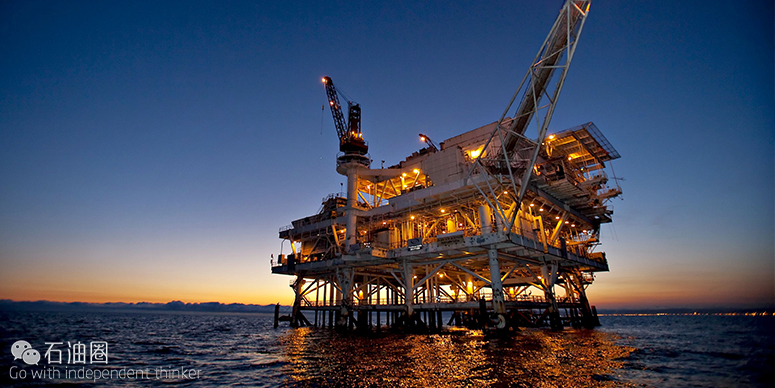The EPCON CFU* compact flotation unit technology separates oil from produced water, decreasing the oil content to below 5 ppm. It has a smaller volume and shorter retention time than traditional flotation units.
The produced water enters the EPCON CFU vessel in a horizontal, tangential direction.
The separation process is aided by internal devices and a gas flotation effect caused by the release of residual gas from the water, added gas, or both. Oil droplets then agglomerate and coalesce, facilitating separation from the water. Treated water exits through the bottom of the vessel. Separated oil and gas are removed in a continuous process via an inserted pipe at the top of the vessel.
This multiphase flow—called the reject—is controlled by a valve located on the outlet pipe. The liquid rate of the reject typically reflects 1% of the overall inlet water flow to the EPCON CFU technology, and the oil content in the stream is normally between 0.5% and 10%. The EPCON CFU technology capacity ranges from 905 bbl/d [6 m3/h] to 173,600 bbl/d [1,150 m3/h].
Design philosophy
- significantly enhance standard, well-established gas flotation design principles by integrating them with confined swirling flow theory, producing a compact, high-performance produced water polishing system
- ensure suitability for floating production storage and offloading (FPSO) applications, where the EPCON CFU design suppresses the negative effects of motion-induced sloshing during bad weather
- maximize simplicity, ease of control, and separation performance while minimizing space and weight of the package
- improve safety by reducing harmful soluble oil pollutants, such as polycyclic aromatic hydrocarbons (PAHs), alkylated phenols, benzene, toluene, ethylbenzene, and xylenes (BTEX compounds).
Measurable results
Single-step separation using EPCON CFU technology degasses water while reducing oil-in-water (OIW) content to below 10 mg/L; serially operating two EPCON CFU technologies can reduce the OIW content to below 5 mg/L. Introducing chemicals such as flocculants and water clarifiers to the operation further enhances separation efficiency. Additionally, the technology’s gas-stripping effect, optimized reduction in dispersed oil, and use of flotation gas has reduced PAH emission by 83% and BTEX emission by 88%.
New-build systems
EPCON CFU technologies form an integral part of Schlumberger Produced Water & Sand Management services. Our new-build systems range from fully automated packaged systems to stand-alone vessels. The technology’s makeup materials range from standard- and low-temperature carbon steels—which can be internally lined according to customer specification—up to high-grade alloys like duplex stainless steel and titanium.
Standard-pressure vessel designs accommodate most pressures, temperatures, and design codes, including British Standards Institution PD 5500; American Society of Mechanical Engineers (ASME) Section VIII; Australian/New Zealand Standard AS 1210; and Euro-Asian Council for Standardardization, Metrology, and Certification (EASC) State Standard GOST-R.
Additional services
Schlumberger also provides a series of added-value services that complement EPCON CFU technology.
- Field testing assesses the expected performance of EPCON CFU technology in a full-scale installation. Comprising two vessels and accessories, field test equipment can treat up to 905 bbl/d [6 m3/h]. Two people can easily carry or move the equipment for testing at different locations
- Field survey work ensures that EPCON CFU technology can integrate into any existing treatment process, as well as explore potential optimizations to an existing system to enhance performance
- Prestudy services involve deploying highly-skilled Schlumberger process engineers prior to produced water evaluation for projects relating to treatment
- Short- and long-term skid-based rental systems across the size and treatment-capacity spectrum can be leased
- Training programs, based at either a Schlumberger training facility or on site, combine theory, computer-base simulations, and practical operations to help teams and individuals better understand process technology and functions
EPCON Dual: Advanced multistage compact flotation unit technology
The EPCON Dual* compact flotation unit (CFU) efficiently removes oil from produced water, decreasing oil content for compliant overboard disposal. Its redeveloped internal design enables 50% greater oil removal efficiency in the same footprint as conventional technologies.
Innovative internal design
The technology’s redesigned vessel utilizes previously lost excess gas to remove larger
amounts of flotation gas bubbles that carry oil and further improved OIW separation efficiency. The separation process is aided by a gas flotation effect caused by the release of residual gas from the water, added gas, or both. Oil droplets are made to agglomerate and coalesce, facilitating separation from water. Treated water exits through the bottom of the EPCON Dual CFU.
Measurable results
The EPCON Dual CFU’s gas-stripping effect, optimized reduction in dispersed oil, and use of nitrogen as flotation gas can reduce polycyclic aromatic hydrocarbon emissions up to 83%. Alkylated phenols and benzene, toluene, ethylbenzene, and xylene (BTEX) compounds are reduced up to 88%.
The innovative technology was developed through computational fluid dynamics simulation, pilot testing, and offshore verification. A successful field trial was performed in the Norwegian sector of the North Sea in cooperation with Statoil that verified 27% better separation rates compared with traditional technologies. Additionally, pilot testing in an onshore controlled environment concluded in 75% greater oil removal efficiency compared with traditional technologies.
Customizable design
One single-pressure EPCON Dual CFU can accommodate flow rates between 500 bbl/d [3 m3/h] and 150,000 bbl/d [1,000 m3/h]. Operating multiple EPCON Dual CFUs in parallel can accommodate higher flow rates.
The CFU’s makeup materials range from standard- and low-temperature carbon steels—which can be internally lined according to customer specifi- cation—to high-grade alloys such as duplex stainless steel and titanium.
Standard-pressure vessel designs accommodate most pressures, temperatures, and design codes, including British Standards Institution PD 5500; American Society of Mechanical Engineers (ASME) Section VIII; Australian/New Zealand Standard AS 1210; and EuroAsian Interstate Council for Standardization, Metrology and Certification Pressure Equipment Directive EN13445, and GOST R Certificate of Conformity.
APPLICATIONS
- Water polishing
- Debottlenecking
- Bulk oil removal
- Gas condensate production
BENEFITS
- Significant space savings
- Increased reliability
- More efficient and streamlined operations
- Enhanced safety
FEATURES
- Improved capacity and reduced footprint
- Higher-performance oil-in-water (OIW) removal
- Robust construction and long operating life
- No moving parts, minimized maintenance, and simplified control requirements
- No external energy required
- Compliance with strict industry standards for permissible produced water overboard disposal limits
- Reduced emission of soluble-oil pollutants


 石油圈
石油圈
